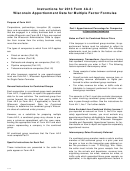Instructions For 2013 Form 4a-2 Page 2
ADVERTISEMENT
Form 4A-2 Instructions
Part I-D: Pipeline Companies
the year the gain or loss is recognized. See the in-
structions for Form 4A-1, line 15 for details.
The apportionment percentage is the average of the
following three ratios:
Part I-A: Air Carriers
1. Net cost (for Wisconsin tax purposes) of tangible
property owned and used in Wisconsin to pro-
The apportionment percentage is the average of the
duce apportionable income to total net cost of
following three ratios:
such property everywhere.
1. Aircraft arrivals and departures within Wisconsin
2. Total compensation paid to employees located in
scheduled by the carrier to total aircraft arrivals
Wisconsin to total compensation paid to employ-
and departures scheduled.
ees everywhere.
2. Revenue tons handled by the carrier at airports
3. Traffic units (for example, barrel miles, cubic foot
within Wisconsin to total revenue tons handled.
miles, or other appropriate measure of product
3. Originating revenue within Wisconsin to total orig-
movement) in Wisconsin to total company traffic
inating revenue.
units.
See section Tax 2.46, Wisconsin Administrative
See section Tax 2.48, Wisconsin Administrative
Code, for further details.
Code, for further details.
Part I-B: Motor Carriers
Part I-E: Telecommunications Companies
The apportionment percentage is the average of the
The apportionment percentage is the average of the
following two ratios:
property factor, payroll factor, and sales factor. Sales
of telecommunications services are in Wisconsin if
1. Gross receipts from carriage of persons or prop-
the purchaser of the service received the benefit of
erty first acquired for carriage in Wisconsin to to-
the service in Wisconsin.
tal gross receipts from carriage of persons or
property everywhere.
See section Tax 2.502, Wisconsin Administrative
2. Ton miles of carriage in Wisconsin to ton miles of
Code, for further details. This section explains where
carriage everywhere. If the above information
the benefit of the service is considered received for
isn’t available, the Department may authorize or
specific types of telecommunications services.
direct the substitution of a similar factor (for ex-
ample, gross tonnage instead of gross receipts or
revenue miles instead of ton miles).
Part II: Conversion to Modified Sales Factor for
See section Tax 2.47, Wisconsin Administrative
Combined Return Filers
Code, for further details.
Combined return filers complete Part II to convert the
Part I-C: Railroads and Sleeping Car Companies
apportionment percentage they computed in Part I to
the “modified sales factor” amounts that will deter-
The apportionment percentage is the average of the
mine their Wisconsin share of combined unitary in-
following two ratios:
come.
1. Gross receipts from carriage of property or per-
■ Line 1. Sales Factor Amounts – Even if the cor-
sons, or both, first acquired for carriage in Wis-
poration did not use a sales factor in Part I, you must
consin to total gross receipts from carriage of
complete lines 1a through 1l.
property or persons, or both, everywhere.
2. Revenue ton miles of carriage in Wisconsin to
■ Line 3. Intercompany Adjustments – Intercom-
revenue ton miles of carriage everywhere.
pany sales between combined group members must
be eliminated from the amounts on lines 1a through
See section Tax 2.475, Wisconsin Administrative
1l. If you included any sales between combined
Code, for further details
group members on lines 1a through 1l, enter on line 3
the amount so included. See the instructions for In-
tercompany Transactions under Part I for details.
2
ADVERTISEMENT
0 votes
 1
1 2
2 3
3








